Posted by: site admin @ 8:33 am
The Garden Diet
“Constantly review your own
behaviour, but do not
Look at the
short-comings of others. Be harmonious and do
not contend with
others” Moon Lamp Samadhi Sutra
[Samadhirajachandrapradipa Sutta])
COMPREHENSIVE PALI COURSE
LESSON 6
Declension of Feminine Gender words ending in ā
Vibhatti Ekavacana Bahuvacana
1. Paṭhamā ā ā, āyo
2. Dutiyā aṁ ā, āyo
3. Tatiyā āya ābhi, āhi
4. Catutthī āya ānaṁ
5. Pañcami āya ābhi, āhi
6. Chaṭṭhi āya ānaṁ
7. Sattamī āya, āyaṁ āsu
8. Ālapana e ā, āyo
For example: Vācā =
Speech
Vibhatti Ekavacana Bahuvacana
1. Paṭhamā Vācā Vācā, Vācāyo
2. Dutiyā Vācāṁ Vācā, Vācāyo
3. Tatiyā Vācāya Vācābhi, Vācāhi
4. Catutthī Vācāya Vācānaṁ
5. Pañcami Vācāya Vācābhi, Vācāhi
6. Chaṭṭhi Vācāya Vācānaṁ
7. Sattamī Vācāya, Vācānaṁ Vācāsu
8. Ālapana Vāce Vācā,
Vācāyo
Word similarly declined are:
Avijjā = ignorance
Taṇhā = craving
Icchā = wish
Vipassanā = insight
Sikkhā = training
Mettā = universal love
Karuṇā = compassion
Muditā = alutruistic joy
Upekkha = equanimity
Saddhā = faith, confidence
Bhāvanā = meditation, development
Sālā = hall
Dhammasālā = preaching hall
Guhā = cave
Nāvā = boat
Pajā = mankind, people
Vocabulary:
Masculine
Soka =
sorrow
Parideva =
lamentation
Samudaya = origin, arising
Nirodha = extinction, cessation
Anta = end
Dīpa = island
pāṇātipātā = from killing
Micchācārā = from sexual misconduct
Musāvādā = from falsehood, lying
Meraya = fermented drink
Pamādaṭṭhānā = from that which beclouds the
Mind
Sikkhāpadaṁ = precept
Kuto = from where, whence
Samādiyāmi = saṁ+ā+dā = I voluntarily undertake
Neuter
Viriya = energy, effort
Mūla = root
Domanassa = sadness, depression
Somanassa = joy
Nibbāna = cessation (of suffering), Ultimate
Bliss.
Adinnādāna = stealing
Kāma = passion, lust, sensuality
Sūrā = wine, liquor
Majja = intoxicating drink
Veramaṇī = abstinence or refraining
FREE ONLINE TRAINING ON BUDDHISM FOR CHILDREN -7
What do Buddhist believe?
Buddhist believe that the Buddha saw the truth about what the
world is like. They believe that nothing in the world is perfect, and that the
Buddha found the answer to why it is like this. They do not believe that the
Buddha was a god. He was a human being just like them. They believe that he was
important because he gained Awakenment, and he chose to teach other people
how to reach it too.
The Three Jewels
There are three Buddhist central beliefs. These are known as
the three jewels as they are felt to be so precious.
- Belief in Buddha
- Dhamma - The teaching of
Buddha - The Sangha - the Buddhist
community made up of ordinary people as well as the monks and nuns. The
purpose is to help others and by doing so to cease to become selfish and
to move on the way towards Awakenment.
One important belief involves reincarnation: the concept that
one must go through many cycles of birth, living, and death. After many such
cycles, if a person releases their attachment to desire and the self, they can
attain Nibbana - a state of liberation and freedom from
suffering.
Four Noble Truths and The Eightfold Path which lead
the Buddhist towards the path of Awakenment.
Lakshman
July 29, ‘09
Lesson 5
In our everyday conversations, we frequently use the words “You” and
“I”. What do we mean by the labels “You”, “I” ? You may say that we
are human beings. If so, what is meant by “human being” ?
According to Buddha’s teaching, a human being is the combination of
five ever-changing aggregates: matter, sensations, perceptions, mental
formations, consciousness - with no external forces whatsoever. We
shall consider each of these aggregates separately. We may note here
that each one of the five aggregates is the result of a cause,
according to the doctrine of dependent origination (to be dealt with
later) in Buddhist philosophy. We may also note that mind which plays
its role in the fourth aggregate of mental formations is according to
Buddha’s teaching one of our six senses, the other five senses being
seeing, hearing, smelling, tasting and touching. As our sixth sense,
mind plays its role for all our thoughts and ideas.
The combination of the five aggregates is always in an ever-changing
flux, which has no self, no soul. The so-called “I” is such a
combination in a flux, so also “You”, without self, without soul.
Buddhism stands unique in the history of human thought in denying the
existence of soul, self (‘atman’). According to the teaching of the
Buddha, the idea of self is imaginary, false belief which has no
corresponding reality and it produces harmful thoughts of ‘me’ and
‘mine’, selfish desire, craving, attachment, hatred, ill-will, conceit,
pride, egoism and other defilements, impurities and problems. It is the
source of all the troubles in the world — from personal conflicts to
wars between nations. In short, to this false view can be traced all
the evils in the world.
P.P. Lakshman
Email: pplakshman08@gmail.com
Telephone: 917-664-6566
A Permanent Online International Seminar on Buddhism and Buddhist Heritage of Jambudvipa, that is, the Great Prabuddha Bharath -1
The Meaning of the Word Buddha
 The term Buddha means “Awakened”. As he fully comprehended
The term Buddha means “Awakened”. As he fully comprehended
the Four Noble Truths and as he arose from the slumbers of ignorance he is
called a Buddha. Since he not only comprehends but also expounds the doctrine
and awakens others, He is called a Samma-Sambuddha –a Fully Awakened One.
Before
His Awaken-ness he was
a bodhisattva which means one who is
aspiring to attain Buddhahood. He was not born a Buddha, but became a Buddha by
his own efforts. Every aspirant to Buddhahood passes through the
bodhisattva period — a period comprising many lives over a vast period of time.
During this period he undergoes intensive spiritual exercises and develops to perfection
the qualities of generosity, discipline, renunciation, wisdom, energy,
endurance, truthfulness, determination, benevolence and perfect equanimity.
In a particular era there arises only one Fully Awakened Buddha. Just as certain
plants and trees can bear only one flower, even so one world-system can
bear only one Fully Awakened Buddha.
“Monks, there is
one person whose birth into this world is for the welfare and
happiness of many, out of compassion for the world, for the gain and
welfare and happiness of gods and humanity. Who is this one person? It
is the Tathâgata, who is a Worthy One, a Fully Awakened One ~
Anguttara Nikaya”
The Buddha was a unique being. Such a being arises but
rarely in this world, and is born out of compassion for the world, for the good,
benefit, and happiness of gods and men. The Buddha is called by many epithets,
among them The Great Physician, The Giver of Deathlessness, The Lord of the
Dhamma (Doctrine). As the Buddha himself says, “He is the
Accomplished One, the Worthy One, the Fully Awakened One.” The Buddha
had no teacher for His Awaken-ness. His knowledge of the secrets of all
existence was realized by himself through his own intuitive wisdom.
“Hard is it to be born a
man; hard is the life of mortals. Hard is it to gain the opportunity of hearing
the Sublime Truth, and hard to encounter is the arising of the Buddhas.~
Dhammapada 182″
Who is the Buddha?
One may think that the Buddha was a human. But the Buddha
denied this too. Once a Brahmin named Dona, approached the Buddha and
questioned him.
“Your Reverence will be a deity ?”
“No, indeed, brahmin, a deity am I not,” replied the Buddha.
“Then Your Reverence will be a god?”
“No indeed, brahmin, a god am I not.”
“Then Your Reverence will be a human being?”
“No indeed, brahmin, a human being am I not.”
“Who, then will Your Reverence be?”
The Buddha replied that He had destroyed Defilements which conditions rebirth as
a god or a human being and added:
“As a lotus, fair and lovely, By the water is not soiled, By the world am I not soiled; Therefore, brahmin, am I Buddha!”
The Buddha had discovered the path to liberation from the
cycles of continued rebirth in this world. Out of compassion for the world, he
shows the path and method whereby he
delivered himself from suffering and death and achieved man’s ultimate goal. It is
left for man to
follow the path.
Be islands unto
yourselves, refuges unto yourselves, seeking no external refuge; with the
Dhamma as your island, the Dhamma as your refuge, seeking no other refuge ~
Maha Parinibbana sutta”
These significant words uttered by the Buddha in his last
days are very striking and inspiring. They reveal how vital is self-exertion to
accomplish one’s ends, and how superficial and futile it is to seek redemption
through self-proclaimed saviours, and to crave for illusory happiness in an afterlife
through the propitiation of imaginary gods by fruitless prayers and meaningless
sacrifices.
The Buddha was a human being. As a man he was born, as a
Buddha he lived, and as a Buddha his life came to an end. Though human, he
became an extraordinary man owing to his unique characteristics. The Buddha laid
stress on this important point, and left no room for any one to fall into the
error of thinking that he was an immortal being. This is important as he sets an
example for what we too can achieve if we are to put effort in practising his
teachings.
The Buddha’s
Greatness Born a man, living as a mortal, by his own exertion he
Born a man, living as a mortal, by his own exertion he
attained the supreme state of perfection called Buddhahood, and without keeping
his Awaken-ness to himself, he proclaimed to the world the latent
possibilities and the invincible power of the human mind. Instead of placing an
unseen Almighty God over man, and giving man a subservient position in relation
to such a conception of divine power, the Buddha demonstrated how man could attain the
highest knowledge and Supreme Awaken-ness by his own efforts. He thus raised
the worth of man. He taught that man can gain his deliverance from the ills of
life and realize the eternal bliss of Nibbana without depending on an external
God or mediating priests.
He taught the egocentric, power-seeking world the noble
ideal of selfless service. He protested against the evils of caste-system that
hampered the progress of mankind and advocated equal opportunities for all. He
declared that the gates of deliverance were open to all, in every condition of
life, high or low, saint or sinner, who would care to turn a new leaf and aspire
to perfection. He raised the status of down-trodden women, and not only brought
them to a realization of their importance to society but also founded the first
religious order for women. He banned the sacrifice of unfortunate animals and
brought them within his compass of loving kindness.
“Driven by fear, men go for refuge to many places — to hills, woods,
groves, trees and shrines. Such, indeed, is no safe refuge; such is not the
refuge supreme. Not by resorting to such a refuge is one released from all
suffering. He who has gone for refuge to the Buddha, the Teaching and his Order,
penetrates with transcendental wisdom the Four Noble Truths — suffering, the
cause of suffering, the cessation of suffering, and the Noble Eightfold Path
leading to the cessation of suffering. This,
indeed, is refuge secure. By seeking such refuge one is released from all
sorrow.
~ Dhammapada 188-192″
He did not force his followers to be slaves either to his
teachings or to himself, but through teaching the famous
Kalama Sutta, granted complete freedom of thought and admonished
his followers to accept his words only after subjecting them to a thorough
examination.
He comforted the bereaved who had lost loved ones. He
ministered to the deserted sick with his hands. He helped the poor and
the neglected. He ennobled the lives of criminals and courtesans and accepted
them into his order of monks. The
rich and the poor, the saint and the criminal, loved him alike. His noble
example was a source of inspiration to all. He was the most compassionate and
tolerant of teachers.
1. Dhammacakkappavattana Sutta
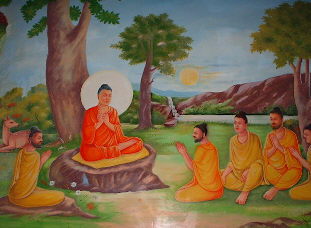
The Sutta
I have heard that on one occasion the Blessed One was staying at
Varanasi in the Game Refuge at Isipatana. There he addressed the group
of five monks:
“There are these two extremes that are not to be indulged in by
one who has gone forth. Which two? That which is devoted to sensual
pleasure with reference to sensual objects: base, vulgar, common,
ignoble, unprofitable; and that which is devoted to self-affliction:
painful, ignoble, unprofitable. Avoiding both of these extremes, the
middle way realized by the Tathagata — producing vision, producing
knowledge — leads to calm, to direct knowledge, to self-awakening, to
Unbinding.
“And what is the middle way realized by the Tathagata that —
producing vision, producing knowledge — leads to calm, to direct
knowledge, to self-awakening, to Unbinding? Precisely this Noble
Eightfold Path: right view, right resolve, right speech, right action,
right livelihood, right effort, right mindfulness, right concentration.
This is the middle way realized by the Tathagata that — producing
vision, producing knowledge — leads to calm, to direct knowledge, to
self-awakening, to Unbinding.
“Now this, monks, is the noble truth of stress:1 Birth is
stressful, aging is stressful, death is stressful; sorrow, lamentation,
pain, distress, & despair are stressful; association with the
unbeloved is stressful, separation from the loved is stressful, not
getting what is wanted is stressful. In short, the five
clinging-aggregates are stressful.
“And this, monks, is the noble truth of the origination of
stress: the craving that makes for further becoming — accompanied by
passion & delight, relishing now here & now there — i.e.,
craving for sensual pleasure, craving for becoming, craving for
non-becoming.
“And this, monks, is the noble truth of the cessation of
stress: the remainderless fading & cessation, renunciation,
relinquishment, release, & letting go of that very craving.
“And this, monks, is the noble truth of the way of practice
leading to the cessation of stress: precisely this Noble Eightfold Path
— right view, right resolve, right speech, right action, right
livelihood, right effort, right mindfulness%2
Illustration Saluting Indian Force Officers Cannons stock images in HD
and millions of other royalty-free stock photos, illustrations and
vectors in the Shutterstock collection. Thousands of new, high-quality
pictures added every day.
National Emblem Symbols Indian Navy Air stock images in HD and millions
of other royalty-free stock photos, illustrations and vectors in the
Shutterstock collection. Thousands of new, high-quality pictures added
every day.
Indian Armed Forces are the military forces of the Republic of India.
It consists of three professional uniformed services: the Indian Army,
Indian Navy, and Indian Air Force.[11] Additionally, the Indian Armed
Forces are supported by the Central Armed Police Forces,[12] Assam
Rifles, Indian Coast Guard and Special Frontier Force and various
inter-service commands and institutions such as the Strategic Forces
Command, the Andaman and Nicobar Command and the Integrated Defence
Staff. The President of India is the Supreme Commander of the Indian
Armed Forces but the executive authority and responsibility for national
security is vested in the Prime Minister of India and their chosen
Cabinet Ministers.[13][14][15][16] The Indian Armed Forces are under the
management of the Ministry of Defence of the Government of India. With
strength of over 1.4 million active personnel,[17][18] it is the world’s
second-largest military force and has the world’s largest volunteer
army.[19] It also has the third-largest defence budget in the world.[20]
The Global Firepower Index report lists it as the fourth most-powerful
military.[21]
is important to note that the Central Armed Police Forces, which are
referred to as ‘Armed Police Forces’ are not armed forces. As such they
are headed by civilian officers from the Indian Police Service and are
under the control of the Ministry of Home Affairs, not the Ministry of
Defence.
Indian armed forces have been engaged in a number of major military
operations, including: the Indo-Pakistani wars of 1947, 1965 and 1971,
the Portuguese-Indian War, the Sino-Indian War, the 1967 Cho La
incident, the 1987 Sino-Indian skirmish, the Kargil War, and the Siachen
conflict among others. India honours its armed forces and military
personnel annually on Armed Forces Flag Day, 7 December. Armed with the
nuclear triad,[22] the Indian armed forces are steadily undergoing
modernisation,[23] with investments in areas such as futuristic soldier
systems and missile defence systems.[24][23]
Department of Defence Production of the Ministry of Defence is
responsible for the indigenous production of equipment used by the
Indian Armed Forces. It comprises the 41 Indian Ordnance Factories under
the control of the Ordnance Factories Board, and eight Defence PSUs
namely: HAL, BEL, BEML, BDL, MDL, GSL, GRSE and Midhani.[6] India
remains one of the largest importer of defence equipment with Russia,
Israel, France and the United States being the top foreign suppliers of
military equipment.[25] The Government of India has launched a Make in
India initiative to indigenise manufacturing and reduce dependence on
imports, including defence imports and procurement.[26]

20 EASY Vegetables to Grow in Pots for Beginners
Do you want EASY vegetables to grow in pots?
Do you want a garden, but don’t have the time, energy, or money for it?
Based on personal experience, scientific studies, and extensive research, I have created a list of 20 EASY Vegetables to Grow in Pots for Beginners.
[toc]
The goal of this article is to provide you with the EASIEST Vegetables to Grow.
Also, I am providing the
necessary instructions on how to select the correct supplies, planting,
caring, harvesting tips, and answers to frequently answered questions.
20 EASY Vegetables to Grow in Pots
Below, you will find the 20 EASIEST Vegetables to Grow in Pots.
You’ll notice squash, cucumbers, sweet corn doesn’t make the list. You can grow them in pots, but it takes too much work to be considered easy.
I also recommend purchasing your vegetable plants from Amazon.
Using seeds is too difficult and time-consuming.
1. Spinach

Spinach is a nutritious vegetable that is grown in both cold and warm
weather. It contains high amounts of vitamin B6, B9, C, and Folic
Acid.
You can plant it as early as spring and as late as early fall.
You can use it in salads, meat and fish dishes, and even eat it by itself.
- Container Size: 5-gallon window box
- When to Plant: Immediately after last spring frost. A second planting in Early Fall
- How to Grow it: Plant 4-6 inches deep. Plant 6-8 inches apart.
- Watering Needs: Water Immediately after planting and then twice a week for 15 seconds.
- Where to place it: Partial-Sun
- Life Cycle: Annual Plant
- When to Harvest: Slowly pick 30 days after planting
2. Lettuce

Lettuce is another nutritious plant that is cold hardy and can flourish in warm weather. It is high in fiber and manganese.
You can plant it immediately after your last frost. You can also plant it throughout the summer and early fall.
Lettuce is great in salads, on sandwiches, or paired with meat and poultry.
- Container Size: 5-gallon window box
- When to Plant: Immediately after last spring frost. A second planting in Early Fall
- How to Grow it: Plant 4-6 inches deep. Plant 6-8 inches apart.
- Watering Needs: Water Immediately after planting and then twice a week for 15 seconds.
- Where to place it: Partial-Sun
- Life Cycle: Annual Plant
- When to Harvest: Slowly pick 30 days after planting
3. Asian Greens
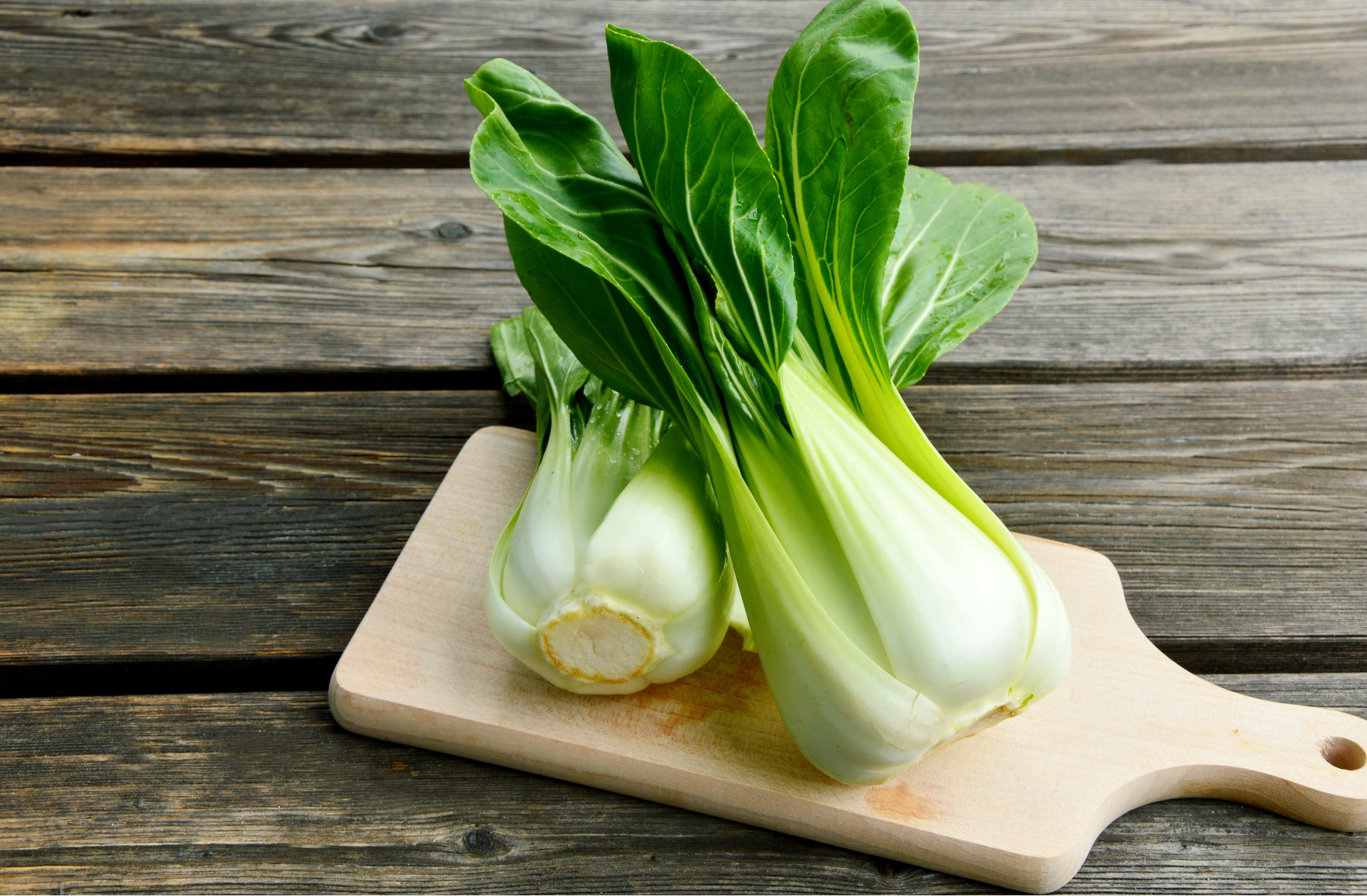
Asian
greens are one of the most nutritious foods on this list. And best of
all, they can be grown at any time of the year. Asian greens contain
vitamins A, B, C, E, and K.
As with lettuce and spinach, Asian greens are great in salad, paired with meat and poultry, and cooked on its own.
- Container Size: 5-gallon window box
- When to Plant: Immediately after last spring frost. A second planting in Early Fall
- How to Grow it: Plant 6 inches deep. Plant 8-10 inches apart.
- Watering Needs: Water Immediately after planting and then twice a week for 15 seconds.
- Where to place it: Partial-Sun
- Life Cycle: Annual Plant
- When to Harvest: Slowly pick 45 days after planting
4. Onions
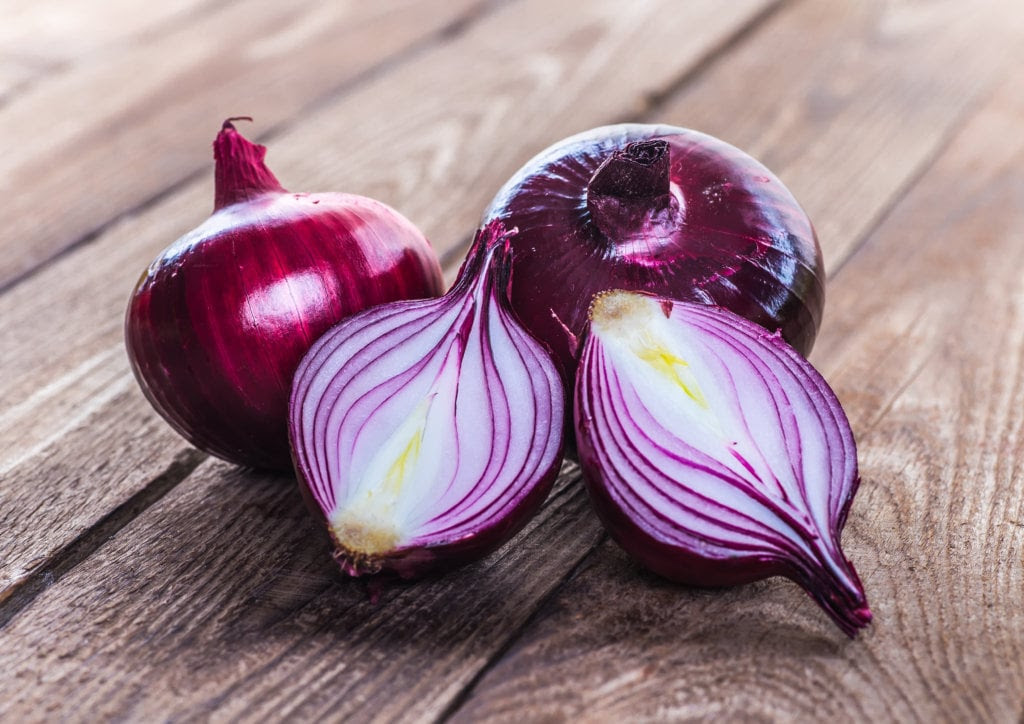
Onions are the perfect vegetable for fiber, folic acid, and vitamin C.
They are a great cold weather vegetable that typically can only be planted in the spring.
They can be eaten raw, have on sandwiches, or added to a stir fry.
- Container Size: 5-gallon pot
- When to Plant: Immediately after last spring frost.
- How to Grow it: Plant 6 inches deep. Plant 6 inches apart.
- Watering Needs: Water Immediately after planting and then once a week for 15 seconds.
- Where to place it: Full-Sun
- Life Cycle: Annual Plant
- When to Harvest: Slowly pick 90 days after planting
5. Green Onions

Green Onions are a great source of Vitamins A, C, & K. In addition, it is a good source of Folic acid and Riboflavin.
Green Onions is another cold hardy plant that can be planted immediately after the last spring frost.
This vegetable can be used in taboule, vegetable dishes, and meat and poultry dishes.
- Container Size: 5-gallon pot
- When to Plant: Immediately after last spring frost.
- How to Grow it: Plant 3 inches deep. Plant 6 inches apart.
- Watering Needs: Water Immediately after planting and then once a week for 15 seconds.
- Where to place it: Full-Sun
- Life Cycle: Perennial Plant
- When to Harvest: Slowly pick 90 days after planting
6. Radishes

Radishes provide a great source of Vitamin C, Folate, and Potassium. It is one of the many easy vegetables to grow in pots.
Radishes are another cold hardy vegetable that can be grown in early spring and again in late summer.
This vegetable is great to pair with cheese, chicken, or in a vegetable salad.
- Container Size: 5-gallon pot
- When to Plant: Immediately after last spring frost and again in late summer (mid-July)
- How to Grow it: Plant 6 inches deep. Plant 6 inches apart.
- Watering Needs: Water Immediately after planting and then once a week for 15 seconds.
- Where to place it: Partial-Sun
- Life Cycle: Annual Plant
- When to Harvest: Slowly pick 90 days after planting
7. Asparagus

Asparagus is one of my favorite perennial vegetables to grow in a
pot. It is a great source of vitamin A, C, E, and K. It also folate,
copper, and iron.
Asparagus can be planted immediately after the last spring frost.
The majority of consumers cook and eat Asparagus with butter as a side dish to their entree.
- Container Size: 5-gallon window box.
- When to Plant: Immediately after last spring frost
- How to Grow it: Plant 3-4 inches deep. Plant 3-6 inches apart.
- Watering Needs: Water Immediately after planting and then once a week for 15 seconds.
- Where to place it: Partial-Sun
- Life Cycle: Perennial Plant
- When to Harvest: Slowly pick 90 days after planting
8. Artichokes

Artichokes are another great perennial plant that has a strong source of vitamins C, K, and Folate.
This is another vegetable you want to plant after the last spring frost and will come up every year.
Artichokes are a great vegetable that can be added warm and cold vegetable and entree dishes.
- Container Size: 5-gallon window box.
- When to Plant: Immediately after last spring frost
- How to Grow it: Plant 4-6 inches deep. Plant 6 inches apart.
- Watering Needs: Water Immediately after planting and then twice a week for 15 seconds.
- Where to place it: Partial-Sun
- Life Cycle: Perennial Plant
- When to Harvest: Slowly pick 90 days after planting
9. Peppers
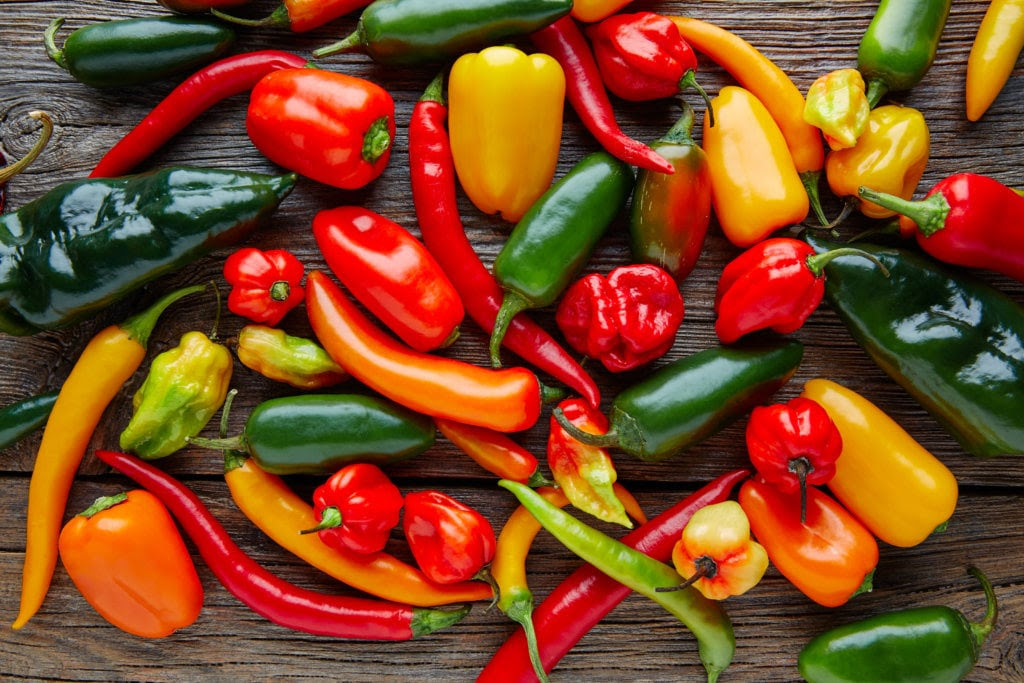
Peppers are my favorite vegetable. They are a great source of iron and vitamin C.
Peppers must be planted one month after your last spring frost. Any sign of frost or cold weather will kill your peppers.
Peppers have many uses. They are used in pasta dishes, stuffed with sausage, and added to salads.
- Container Size: 5-gallon pot.
- When to Plant: One month after last spring frost
- How to Grow it: Plant 6-8 inches deep. Plant 12-14 inches apart.
- Watering Needs: Water Immediately after planting and then two to three times a week for 15 seconds.
- Where to place it: Full-Sun
- Life Cycle: Annual Plant
- When to Harvest: Slowly pick 90 days after planting
10. Tomatoes

Tomatoes were recently voted the most popular vegetable in the United
States. They are rich in vitamin C, potassium, and folate. This is
one of the surprisingly easy vegetables to grow in pots.
Tomatoes should be planted one month after the last spring frost. Any sign of cold weather or frost will kill the plant.
Tomatoes can be made into paste and sauces, added to salads, and vegetable dishes.
It should be noted that I recommend only planting cherry and grape
tomatoes in pots. Other tomatoes will take too much work and care to
make it on this list.
- Container Size: 5-gallon pot.
- When to Plant: One month after last spring frost
- How to Grow it: Plant 8-10 inches deep. Plant 14 inches apart.
- Watering Needs: Water Immediately after planting and then two to three times a week for 15 seconds.
- Where to place it: Full-Sun
- Life Cycle: Annual Plant
- When to Harvest: Slowly pick 90 days after planting
11. Chard
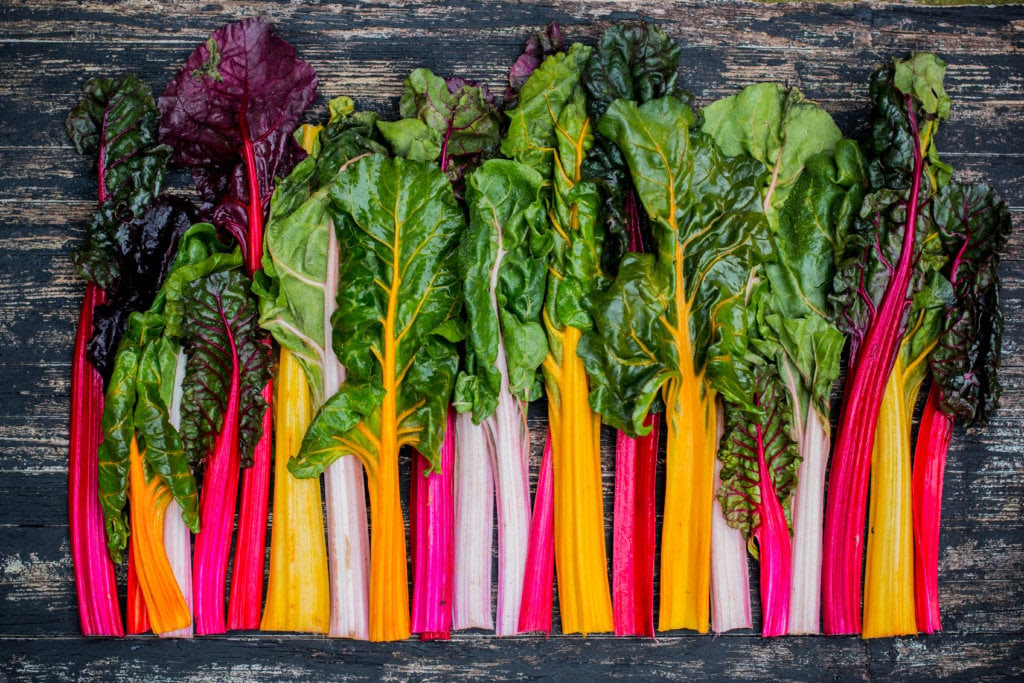
Swiss chard is one of the least known, but most beneficial
vegetables. This vegetable is rich in vitamin c, folic acid, iron, and
potassium.
Swiss Chard is a cold hardy plant that can be planted in early spring and again in the summer.
This vegetable is used in fish dishes, salads, and or even eaten raw.
- Container Size: 5-gallon pot.
- When to Plant: Immediately after the last frost and in early summer.
- How to Grow it: Plant 4-6 inches deep. Plant 6 inches apart.
- Watering Needs: Water immediately after planting and then two to three times a week for 15 seconds.
- Where to place it: Partial-Sun
- Life Cycle: Annual Plant
- When to Harvest: Slowly pick 60 days after planting
12. Kohlrabi
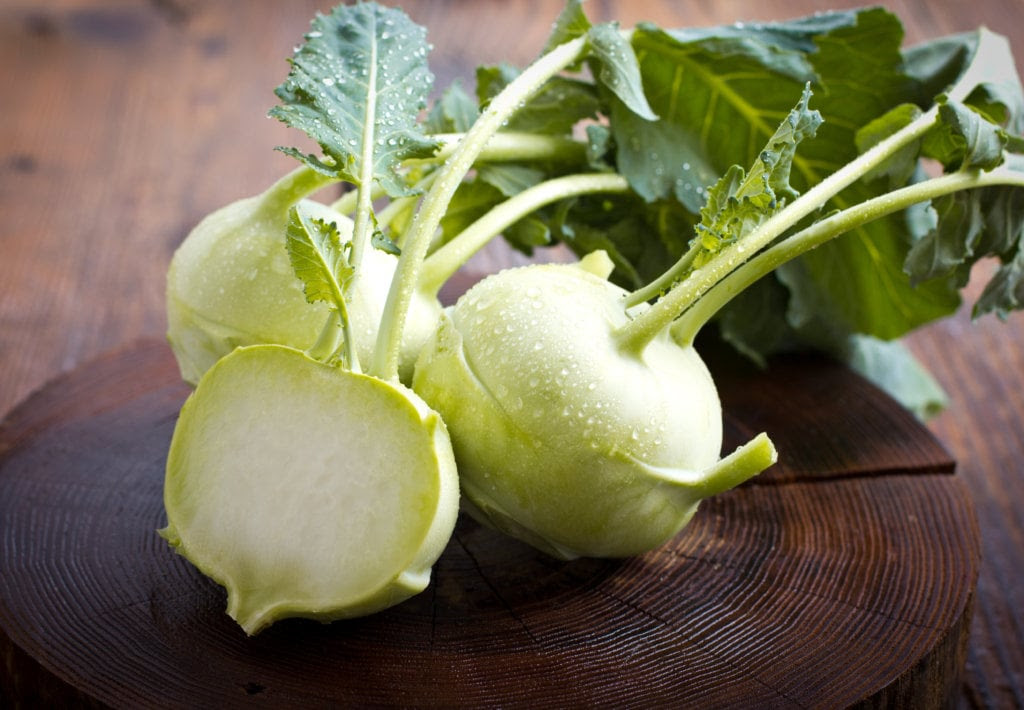
Kohlrabi is becoming an increasingly popular vegetable in the United
States. It is a high source of Thiamin, Folate, Magnesium, and
Phosphorous.
Kohlrabi can be planted immediately after the last frost and again in early summer.
This vegetable cooks with olive oil and other herbs. It serves well as a side dish.
- Container Size: 5-gallon pot.
- When to Plant: Immediately after the last frost and again in early summer.
- How to Grow it: Plant 6 inches deep. Plant 6-8 inches apart.
- Watering Needs: Water Immediately after planting and then two to three times a week for 15 seconds.
- Where to place it: Partial-Sun
- Life Cycle: Annual Plant
- When to Harvest: Slowly pick 60 days after planting
13. Carrots
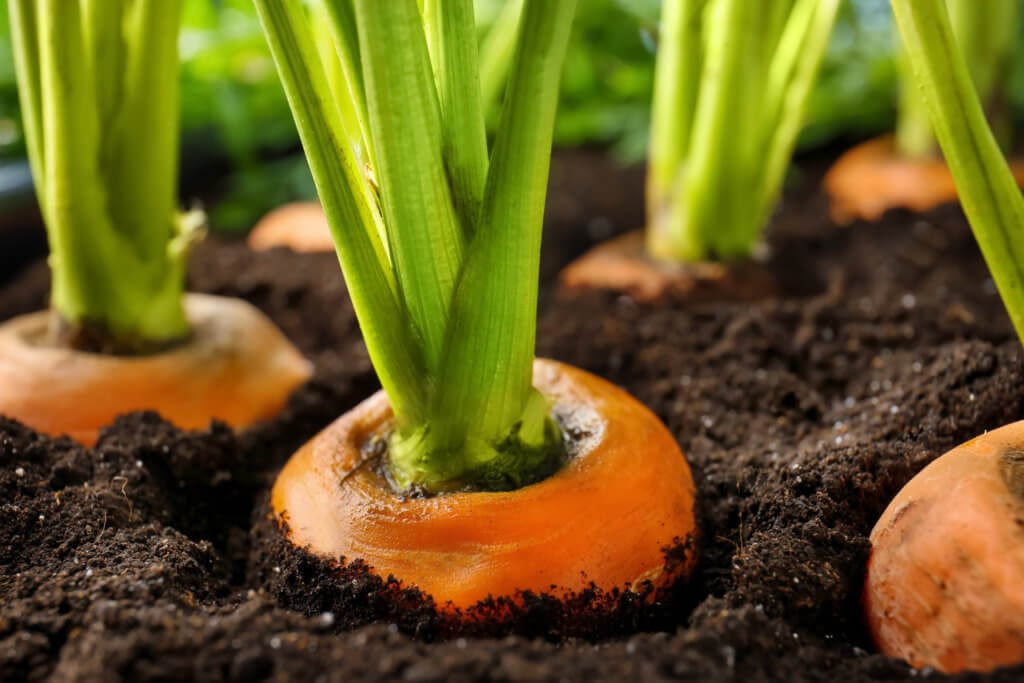
If you follow my instructions carrots are incredibly easy to grow. And they are a great source of vitamin A, K, and potassium.
Typically, you will plant carrots one month after the last spring frost.
Carrots are eaten raw, cooked, in soups, and in meat dishes.
- Container Size: 5-gallon window box
- When to Plant: One month after the last frost.
- How to Grow it: Plant 4-6 inches deep. Plant 3-4 inches apart.
- Watering Needs: Water Immediately after planting and then two to three times a week for 15 seconds.
- Where to place it: Full-Sun
- Life Cycle: Annual Plant
- When to Harvest: Slowly pick 100 days after planting
14. Broccoli

Broccoli is another fantastic vegetable for gardeners. It is a great source of protein, thiamin, and vitamin E.
Broccoli is a cold hardy plant that can be planted immediately after the last frost.
Broccoli is best served cooked with olive oil or cheese but also can be eaten raw.
- Container Size: 5-gallon window box
- When to Plant: Immediately after the last frost
- How to Grow it: Plant 6-8 inches deep. Plant 12 inches apart.
- Watering Needs: Water Immediately after planting and then two to three times a week for 15 seconds.
- Where to place it: Partial-Sun
- Life Cycle: Annual Plant
- When to Harvest: Slowly pick 90 days after planting
15. Beets
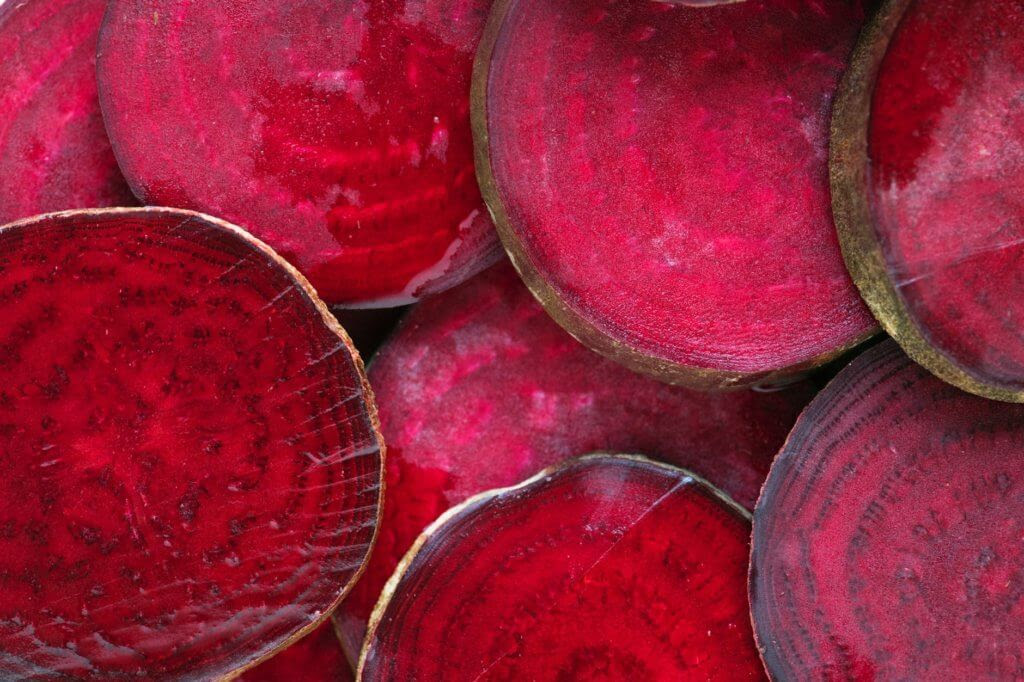
Beets may not be a favored plant among gardeners, but it is high in
nutrients. It is an excellent source of fiber, folate, potassium, and
vitamin C.
Beets can be planted immediately after the last spring frost and again in early summer.
Beets can be eaten raw. They can be pickled. And they can be served in many cooked vegetable dishes.
- Container Size: 5-gallon window box
- When to Plant: Immediately after the last frost
- How to Grow it: Plant 6-8 inches deep. Plant 6 inches apart.
- Watering Needs: Water Immediately after planting and then two to three times a week for 15 seconds.
- Where to place it: Partial-Sun
- Life Cycle: Annual Plant
- When to Harvest: Slowly pick 90 days after planting
16. Kale

Kale has fastly become one of the most popular vegetables in the
world. This vegetable has fiber, protein, almost every vitamin, and
iron.
Kale is a cold hardy vegetable that is planted immediately after the last spring frost and again in early summer.
This vegetable is used in salads, smoothies, and entree dishes.
- Container Size: 5-gallon window box
- When to Plant: Immediately after the last frost
- How to Grow it: Plant 6 inches deep. Plant 6 inches apart.
- Watering Needs: Water Immediately after planting and then two to three times a week for 15 seconds.
- Where to place it: Partial-Sun
- Life Cycle: Annual Plant
- When to Harvest: Slowly pick 90 days after planting
17. Eggplant

Eggplants are one of the most hearty vegetables on this list. They are a rich source of fiber, potassium, and vitamin C.
They should be planted at least a month after the last spring frost.
This type of vegetable is great for pasta dishes and as a side for entrees.
- Container Size: 5-gallon pot
- When to Plant: One month after the last frost
- How to Grow it: Plant 6-8 inches deep. Plant 12 inches apart.
- Watering Needs: Water Immediately after planting and then two to three times a week for 15 seconds.
- Where to place it: Full-Sun
- Life Cycle: Annual Plant
- When to Harvest: Slowly pick 90 days after planting
18. Green Beans

While there are many beans out there, green beans are the best for
pots. Green beans are a high source of folate, fiber, and potassium.
This vegetable should be planted 1 month after the last spring frost and again in early summer.
Typically, green beans are served as a side dish to pasta and other entrees.
- Container Size: 5-gallon window box
- When to Plant: One month after the last frost and again in early summer
- How to Grow it: Plant 3 inches deep. Plant 3-4 inches apart.
- Watering Needs: Water Immediately after planting and then two to three times a week for 15 seconds.
- Where to place it: Full-Sun
- Life Cycle: Annual Plant
- When to Harvest: Slowly pick 60 days after planting
19. Sweet Peas

How delicious are sweet peas? They are also very nutritious. These
vegetables are a high source of protein, riboflavin, and niacin.
Typically, you plant sweet peas about one month after the last frost and again in early summer.
Sweet Peas can be eaten raw right off the plant or cooked and served as a side dish to entrees.
- Container Size: 5-gallon window box
- When to Plant: One month after the last frost and again in early summer
- How to Grow it: Plant 3 inches deep. Plant 3-4 inches apart.
- Watering Needs: Water Immediately after planting and then two to three times a week for 15 seconds.
- Where to place it: Full-Sun
- Life Cycle: Annual Plant
- When to Harvest: Slowly pick 60 days after planting
20. Cauliflower

Cauliflower is a very similar plant to broccoli in regards to how you
plant, care, and harvest it. It is an excellent source of fiber and
multiple B vitamins.
Cauliflower can be planted a little less than one month after the last spring frost.
Like Broccoli, cauliflower can be served raw or cooked with cheese or olive oil.
- Container Size: 5-gallon window box
- When to Plant: One month after the last frost
- How to Grow it: Plant 6-8 inches deep. Plant 12 inches apart.
- Watering Needs: Water Immediately after planting and then two to three times a week for 15 seconds.
- Where to place it: Partial-Sun
- Life Cycle: Annual Plant
- When to Harvest: Slowly pick 60 days after planting
Bonus – EASY Herbs to Grow in Pots
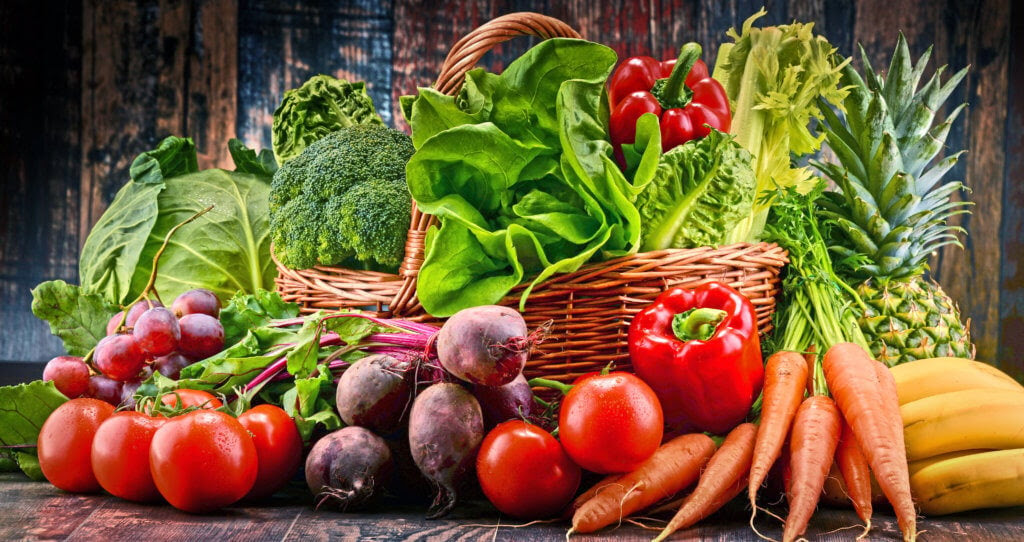
While this article is focused on EASY vegetables to grow in pots, there are also plenty of herbs I recommend growing in pots.
Below, is a list of 10 EASY Herbs to Grow in Pots
Bonus – EASY Fruits to Grow in Pots
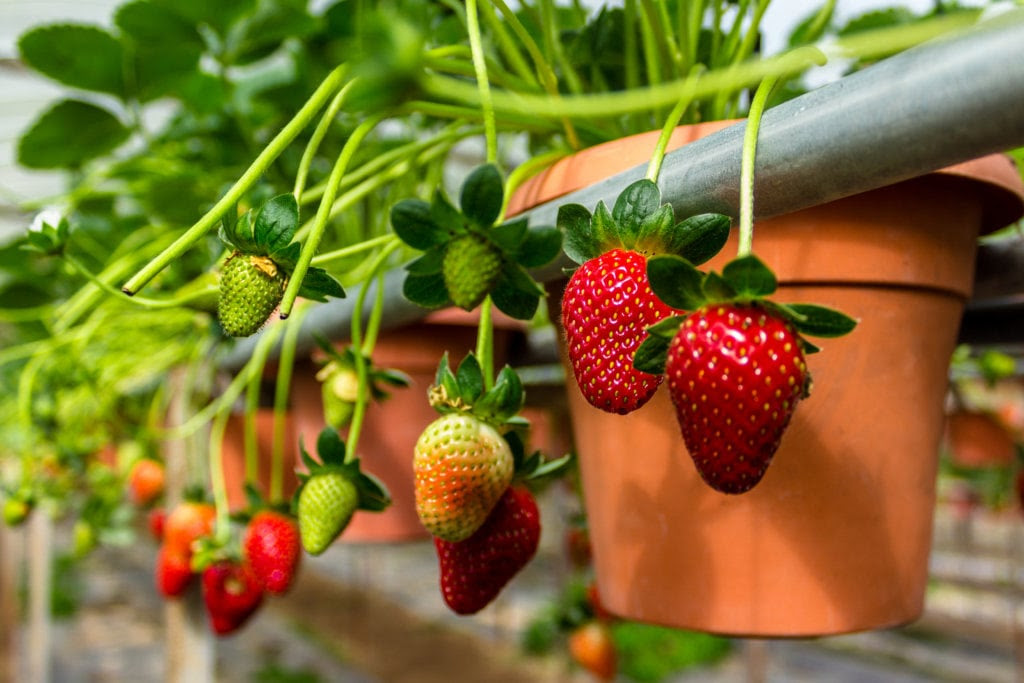
In addition to vegetables and herbs, there are also incredibly EASY fruits to grow in pots.
Below, is a list of the 10 EASIEST Fruits to Grow in Pots
- Strawberries
- Cherry Bush
- Raspberries
- Blueberries
- Lemon Tree
- Fig Tree
- Lime Tree
- Avocado
- Orange Tree
- Grapefruit Tree
Frequently Asked Questions
#1. What is Needed to Grow Vegetables in Pots?

A) Purchase the Correct Pot
Not all pots are created equal. And while your plants may not care, selecting the appropriate pot will help make gardening EASY!
Below, are four types of pots that you can use.
If you are looking for the easiest pot to use then purchase plastic.
- Ceramic–
This is a highly durable and decorative pot that fits great on decks
and patios. This is also one of the most expensive pots and can crack in
cold weather. - Clay –
This is a great option that can be kept inside or outside. It is also
very affordable. It does dry out faster though and can easily break. - Plastic –
This is the best type of pot for overall uses. It can be kept indoor
and outdoor and is the cheapest. It is the least durable and decorative. - Wooden – This is the best outdoor option. It is incredibly durable too. It is also very expensive and can be extremely heavy.
*If you plan on keeping your plant inside, I would recommend purchasing a saucer with it. This will prevent any water from getting onto your floor.
B) Size of Pot
Don’t listen to what a gardening mom says. When it comes to pots, size matters.
You should purchase a container that is 25% to 50% bigger than the
root ball of the plant. The root ball is the bottom of the plant.
If you want to make growing
vegetables easy then buy a bigger pot. Bigger containers hold more soil
which will hold more water. This means less watering for you.
Typically, you want a pot that is 12 inches wide by 12 inches deep.
The perfect size for herbs and small vegetables is 5 gallons. For
larger vegetables like tomatoes and herbs then I recommend purchasing a
10-gallon pot.
C) The Right Soil is Essential
Soil is arguably the most important supply needed for growing vegetables in pots.
If you do not have the right soil your plants may not grow, bear fruit, and can even die.
For any type of vegetable, you plant in a pot then purchase Potting Soil.
It is that Simple!
I personally use and recommend Miracle-Gro Moisture Control Potting Mix.
This is the perfect mix for beginner gardeners. It is easy to use and it helps prevent over and under-watering.
If you want an organic option then use: Fox Farm Organic Potting Soil
D) Use These 3 Tools
If you want minimal frustration with planting, caring, and harvesting your vegetables from pots then you’ll need a few tools.
You will need the following:
- Hand Shovel – This is essential for digging a hole for your plant
- Gloves – If you want minimal work and clean-up then use gloves.
- Watering Can – This is a must-have if you don’t want to create a mess while watering your plants.
#2. How do you Grow Vegetables in Pots?

There are 3 Steps to EASILY Growing Vegetables in Pots
Step 1
First, you will want to determine your last spring frost date. The best way to determine this is by using the USDA Plant Hardiness Zone Map for your zip code.
To plant your vegetables, you will first want to take your pot and
place it in an area that either gets direct or partial sunlight. Where
you place, it depends on which vegetable you use from the above list.
You will then fill your pot with your potting soil. Fill it to about 3 inches from the top.
Step 2
Next, you will dig a hole based on your vegetable. To see how deep
and how far apart you should plant your vegetables please see the list
above.
You will then cover the base of your plant. The base of your
vegetable is where typically a few inches above its root ball. If you
have purchased a vegetable to plant from Amazon or a local garden store
the root ball will be where the plant meets the “soil mix”.
If you are interested in planting several vegetables in one pot then I recommend using my pairings below:
- Beans, Peas, and Carrots
- Eggplant, Peas, and Beans
- Tomatoes, Onions, and Green Onions
- Lettuce, Kohlrabi, and Chard
- Spinach, Chard, and Onions
- Peppers, Onion, and Green Onions
Step 3
Immediately after planting your vegetable you will want to add
fertilizer. Apply it per the instructions on the back of the fertilizer
package.
For a fertilizer that will work on all your vegetables then I recommend Miracle-Gro All Purpose Plant Fertilizer.
You will then water your plant for about 10-15 seconds.
#3. How do You Care for Vegetables in Pots?
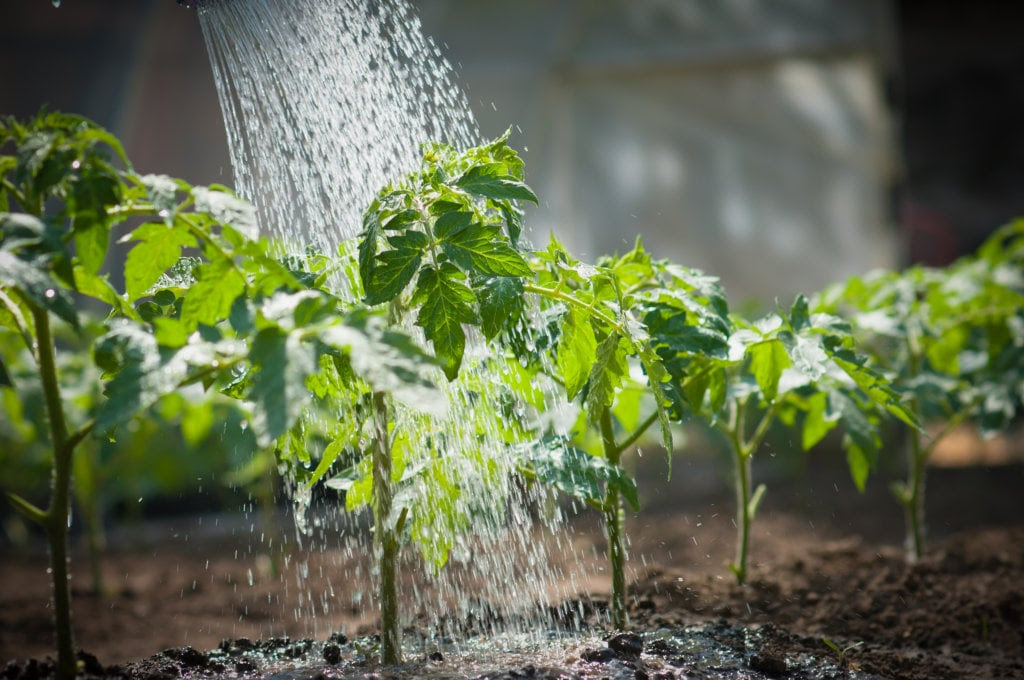
1 EASY Step to Caring for Your Vegetables in Pots
If you want to care for your vegetables in the easiest way possible then there is only one thing you need to do.
Depending on the vegetable you plant you will want to water your
plant one to two times a week. Spend about 10-15 seconds watering each
vegetable plant.
#4. How do You Harvest Vegetables?

1 EASY Step to Harvesting Your Vegetables
If you thought caring for your vegetables in pots was easy then you will be amazed how easy it is to harvest your vegetables.
All you need to do is pick your vegetables when it is ready.
Honestly, it is okay to pick your harvest a little early or a little
late. And if you are still unsure use my harvest time in the above
section and you cannot go wrong.
All you have to do to harvest your crop is pick your vegetable from
where it meets the branch it is growing on. If it is a leafy vegetable
just pinch and pull. If it is a vegetable like a pepper or a tomato
twist it from where the vegetable meets the branch.
Remember
to harvest early and often. This will encourage new growth. This will
also allow you to get a second planting in for certain vegetables.
When you are finished harvesting your plant you can pull it and
compost it. Please review my composting article for more information:
Winter Composting (10 PROVEN Tips)
What to Compost: 9 Best Foods to Compost (and 10 You Shouldn’t)
#5. What are the Best Uses for Vegetables?

There are many uses for vegetables. Regardless of the use,
vegetables are a great wait to add essential vitamins and nutrients to
your diet.
You can:
- Cook vegetables and eat them by themselves
- Add vegetables as a side dish to entrees
- Eat vegetables raw
- Freeze vegetables and save them for later
- Dry vegetables and add them to flavor dishes
- Use the seeds of vegetables to grow more vegetables
Conclusion
As you can tell by now, Growing Vegetables in Pots can be easy and fun!
If you want to have the greatest chance of success then you’ll want to plant one of the 20 EASY Vegetables to Grow in Pots above!
Also, there are plenty of herbs and fruits that can be easily planted in pots.
If you want to make the best use of your space don’t forget to plant
two to three kinds of vegetables, herbs, and fruits together.
Regardless of what you plant, make sure you:
- Purchase the right type of pot for your planting needs
- Purchase the correct tools to make gardening as easy as possible
- Plant
using my easy to follow instructions. Digging the appropriate size
hole, fertilizing, and watering during planting is essential! - The only plant care tip you need to take advantage of is watering 1 to 2 times a week
- Remember to harvest early and often to help promote new vegetable growth and to extend your harvest
If you thought this article was helpful, I highly recommend reading my favorite article:
101 Gardening Tips that ACTUALLY Work
Vegetable GardeningRelated Posts
SearchRecent PostsHere is the BEST Time to Plant Arugula in Hardiness Zone 3 (2022)
The Garden Diet
The Garden Diet
The Garden Diet
Articles
Raw Food Detox Diet: A Dietitian’s Guide
Raw Vegan Meal Plan: How to Follow a Raw Vegan Diet
The Garden Diet
The Garden Diet
Categories
Raw Diets
Raw Vegan Meal Plan: How to Follow a Raw Vegan Diet
Post author
By Amanda A. Kostro Miller, RD, LDN
Post date
February 9, 2021
Raw vegan meal plan
While you may be familiar with vegan diets and even raw food diets, have you ever considered combining the two?
The “raw vegan diet” blends these concepts to create a plant-based, raw vegan meal plan with lots of whole foods.
Let’s
explore the basics, benefits and drawbacks of the raw vegan diet to see
if it’s appropriate for you. Then you can try out this diet, starting
with a 7-day raw vegan meal plan below.
Raw Vegan Diet Overview
As
mentioned, the raw vegan diet combines concepts of “raw food eating”
and veganism. Below is a table that shows the components of the raw
vegan meal plan.
Raw Vegan Diet Philosophy
Raw Food Diet Principles Vegan Diet Principles
Eat only raw, uncooked foods like fruits, vegetables and nuts Avoid all animal foods like meat, poultry and seafood
Emphasize
unprocessed foods like soaked grains and fresh juices Avoid all
animal-based foods like milk, butter, gelatin, honey and eggs
Eat lots of simple, whole foods Avoid foods that contain animal ingredients and/or animal-based ingredients
Avoid refined sugars, packaged snack foods and bakery items Eat only foods that come from plants, nuts and seeds
Raw
foods contain more nutrition than cooked foods (allegedly) Use
alternative dairy sources like almond milk, soy milk and vegan cheese
A
big benefit of the raw vegan diet is that it’s high in fruits,
vegetables, grains, nuts and seeds. It also emphasizes limiting
processed foods for whole, more natural foods.
Is a raw vegan diet safe?
Before
you jump straight into a raw vegan meal plan, there are important
things to consider. This diet is not suitable for everyone. Talk to your
healthcare team prior to starting.
Raw Vegan Diet Drawbacks
Raw Food Diet Issues Vegan Diet Issues
There’s
little evidence to support that raw foods have more nutrition than
properly cooked foods. 4 Can put you at risk for nutrient deficiencies
in protein, calcium, B12, iron, and vitamin D. 3
Not
cooking food to proper temperatures can put you at risk of foodborne
illness. 2 Not necessarily healthier than a diet that includes
animal-based foods.
Should
not be consumed by people with a compromised immune system. Won’t make
you lose more weight than a non-vegan diet (even vegan diets need a
calorie restriction).
Requires
strict, safe food handling like washing your hands, cleaning your
produce and avoiding cross-contamination. 1 Need lots of planning to
make it a well-rounded diet with complete nutrition.
How to Follow a Raw Vegan Diet
Let’s go over what you need and how to get started. Plus, don’t forget about our 7-day raw vegan meal plan below!
Step 1: Load Up on Vegan Foods
The
best way to do this diet is to make sure you’re well-equipped with
nutritious foods. The more variety, the more complete your nutrition
profile will be. Any good vegan diet (and especially a raw vegan meal
plan!) should be rich in:
Fresh fruits
Plain, frozen fruits
Fresh vegetables
Plain, frozen vegetables
Dried fruits and vegetables
Nuts and nut butter
Seeds
Whole grains (such as quinoa)
Legumes (such as beans)
Soy (such as edamame)
Step 2: Store Your Foods Properly
You’re supposed to eat uncooked food while on a raw vegan meal plan. But, don’t just leave stuff on your countertop.
Make
sure you store items in the fridge, freezer or at room temperature,
depending on the food. Here’s a handy fruit and vegetable storage guide!
Step 3: Wash Your Hands and Surfaces Before Prepping
Cooking
helps to kill certain bacteria, but since the goal is to consume raw
food, you’ll have to minimize contamination risk in other areas.
Wash your hands and cooking surfaces before, during and after meal prepping.
Step 4: Properly Wash and Prep Your Food
Here’s
another safeguard against foodborne illness. Many fruits and vegetables
should be properly rinsed and cleaned prior to eating.
Contaminants
from animals, soil, water — and even bacteria on someone’s hand — can
end up on your produce. That’s why it’s really important to wash your
produce before cutting and peeling. Otherwise, bacteria can enter
through a cut in the fruit or vegetable’s skin!
Some quick washing tips from the FDA: 1
Rinse produce before peeling and cutting
Only use clean, running water to rinse (no soap or soaking)
Cut away bruised areas
Use a vegetable brush for tough and firm produce like melons and apples
Dry produce with a clean towel or paper towel
Remove outer leaves of leafy vegetables like cabbage
7-Day Raw Vegan Meal Plan
Want
to try the raw vegan diet? Here’s a simple raw vegan meal plan to help
you get started. Remember: A true raw diet involves no heating or
cooking your meals, so if you want to follow a raw vegan meal plan don’t
use heat when making your meals.
Day 1
Breakfast: Chia pudding with fresh sliced peaches and raspberries. Add cinnamon, nutmeg and walnuts if desired.
Lunch:
Salad bowl with julienned carrots, cabbage and zucchini. Add edamame
and bell peppers. Drizzle with cold-pressed avocado oil and sesame
seeds.
Dinner: Raw miso soup with marinated mushrooms, dried wakame and blended cashews for creaminess.
Snack: Mixed nuts.
Day 2
Breakfast:
Cobbler with a crust made from ground almonds, coconut oil and dates
(all blended in a food processor). Add mango and garnish with mint
leaves and agave.
Lunch: Raw carrot zoodles topped with homemade peanut sauce, ginger and lime.
Dinner: Riced cauliflower sushi wrapped in raw nori.
Snack: Fresh fruit.
Day 3
Breakfast: Banana “sushi” (sliced banana) topped with nut butter, seeds and goji berries.
Lunch:
Creamy gazpacho made from soaked cashews, coconut milk and cucumbers
(all blended). Add lemon juice, garlic and other spices. Garnish with
pine nuts.
Dinner: Stuffed avocado halves with chickpeas, cucumber and soaked quinoa.
Snack: Apple with homemade nut butter.
Day 4
Breakfast: Fruit skewers with pineapple, strawberries and melon. Dip into maple syrup, honey and/or chia seed pudding.
Lunch:
Lettuce boats filled with avocado, tomatoes, alfalfa sprouts, julienned
carrots and shredded cabbage. Add a dollop of homemade lemon-tahini
dressing.
Dinner: Cauliflower rice with raw veggies and edamame. Top with lime juice and cold-pressed oil.
Snack: Banana “nice” cream (frozen banana blended with non-dairy milk).
Day 5
Breakfast: Smoothie made with banana, pineapple, non-dairy milk and ground flax seeds.
Lunch: Stuffed peppers (or mini peppers) with thick garlic, lemon and cashew schmear.
Dinner: Zoodles with avocado pesto sauce.
Snack: Homemade hummus with veggies.
Day 6
Breakfast: Raw oatmeal (soaked overnight) with homemade nut butter, apple slices and cinnamon.
Lunch:
Tomato, basil and avocado salad. Slice the tomatoes and avocados into
disk-shaped pieces. Top with basil and a drizzle of cold-pressed olive
oil.
Dinner: Raw zucchini lasagna with tomato, hummus and pesto.
Snack: Dried fruit with nuts.
Day 7
Breakfast: Peanut butter and banana smoothie with homemade nut butter, frozen banana, unsweetened cocoa powder and soy milk.
Lunch: Veggie lettuce wraps with savory dipping sauce.
Dinner:
Raw veggie pizza. Blend the crust with ground pumpkin seeds, hemp
seeds, sunflower seeds, walnuts, water and lots of seasoning. Spread on a
pesto blend and add raw veggies like tomato and soaked mushrooms.
Snack: Raw flaxseed crackers with guacamole.
This
simple raw vegan meal plan is a great start for anyone looking to try a
raw and vegan diet. If you’re interested in other raw diets, check out
our raw food detox diet guide.
Article Sources
Food and Drug Administration. 7 tips for cleaning fruits,
vegetables. FDA website. Published June 10, 2018. Accessed February 3,
2021.
By Amanda A. Kostro Miller, RD, LDN
Amanda
A. Kostro Miller is a Registered Dietitian from Chicago with experience
in nutrition counseling, weight loss and medical nutrition therapy.
Early on in her career, she worked with United States veterans, patients
with eating disorders and those with a variety of acute and chronic
diseases. She currently writes nutrition content for websites, blogs and
medical software. Amanda also creates podcasts, meal plans and weight
loss guides for a variety of audiences.
Aside from nutrition, Amanda is a military wife and technically-trained professional dancer who performs worldwide.
View Archive →
← Raw Food Detox Diet: A Dietitian’s Guide
The Garden Diet - The Garden Diet
explore the basics, benefits and drawbacks of the raw vegan diet to see
if it’s appropriate for you. Then you can try out this diet, starting
with a 7-day raw vegan meal plan below.
mentioned, the raw vegan diet combines concepts of “raw food eating”
and veganism. Below is a table that shows the components of the raw
vegan meal plan.
unprocessed foods like soaked grains and fresh juices Avoid all
animal-based foods like milk, butter, gelatin, honey and eggs
foods contain more nutrition than cooked foods (allegedly) Use
alternative dairy sources like almond milk, soy milk and vegan cheese
big benefit of the raw vegan diet is that it’s high in fruits,
vegetables, grains, nuts and seeds. It also emphasizes limiting
processed foods for whole, more natural foods.
you jump straight into a raw vegan meal plan, there are important
things to consider. This diet is not suitable for everyone. Talk to your
healthcare team prior to starting.
little evidence to support that raw foods have more nutrition than
properly cooked foods. 4 Can put you at risk for nutrient deficiencies
in protein, calcium, B12, iron, and vitamin D. 3
cooking food to proper temperatures can put you at risk of foodborne
illness. 2 Not necessarily healthier than a diet that includes
animal-based foods.
not be consumed by people with a compromised immune system. Won’t make
you lose more weight than a non-vegan diet (even vegan diets need a
calorie restriction).
strict, safe food handling like washing your hands, cleaning your
produce and avoiding cross-contamination. 1 Need lots of planning to
make it a well-rounded diet with complete nutrition.
best way to do this diet is to make sure you’re well-equipped with
nutritious foods. The more variety, the more complete your nutrition
profile will be. Any good vegan diet (and especially a raw vegan meal
plan!) should be rich in:
sure you store items in the fridge, freezer or at room temperature,
depending on the food. Here’s a handy fruit and vegetable storage guide!
helps to kill certain bacteria, but since the goal is to consume raw
food, you’ll have to minimize contamination risk in other areas.
another safeguard against foodborne illness. Many fruits and vegetables
should be properly rinsed and cleaned prior to eating.
from animals, soil, water — and even bacteria on someone’s hand — can
end up on your produce. That’s why it’s really important to wash your
produce before cutting and peeling. Otherwise, bacteria can enter
through a cut in the fruit or vegetable’s skin!
to try the raw vegan diet? Here’s a simple raw vegan meal plan to help
you get started. Remember: A true raw diet involves no heating or
cooking your meals, so if you want to follow a raw vegan meal plan don’t
use heat when making your meals.
Salad bowl with julienned carrots, cabbage and zucchini. Add edamame
and bell peppers. Drizzle with cold-pressed avocado oil and sesame
seeds.
Cobbler with a crust made from ground almonds, coconut oil and dates
(all blended in a food processor). Add mango and garnish with mint
leaves and agave.
Creamy gazpacho made from soaked cashews, coconut milk and cucumbers
(all blended). Add lemon juice, garlic and other spices. Garnish with
pine nuts.
Lettuce boats filled with avocado, tomatoes, alfalfa sprouts, julienned
carrots and shredded cabbage. Add a dollop of homemade lemon-tahini
dressing.
Tomato, basil and avocado salad. Slice the tomatoes and avocados into
disk-shaped pieces. Top with basil and a drizzle of cold-pressed olive
oil.
Raw veggie pizza. Blend the crust with ground pumpkin seeds, hemp
seeds, sunflower seeds, walnuts, water and lots of seasoning. Spread on a
pesto blend and add raw veggies like tomato and soaked mushrooms.
simple raw vegan meal plan is a great start for anyone looking to try a
raw and vegan diet. If you’re interested in other raw diets, check out
our raw food detox diet guide.
vegetables. FDA website. Published June 10, 2018. Accessed February 3,
2021.
A. Kostro Miller is a Registered Dietitian from Chicago with experience
in nutrition counseling, weight loss and medical nutrition therapy.
Early on in her career, she worked with United States veterans, patients
with eating disorders and those with a variety of acute and chronic
diseases. She currently writes nutrition content for websites, blogs and
medical software. Amanda also creates podcasts, meal plans and weight
loss guides for a variety of audiences.






